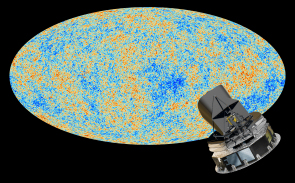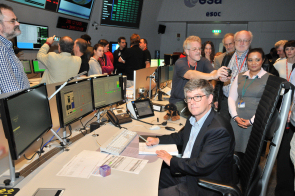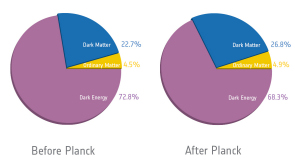Last command sent to ESA's Planck space telescope
23 October 2013
ESA's Planck space telescope has been turned off after nearly 4.5 years soaking up the relic radiation from the Big Bang and studying the evolution of stars and galaxies throughout the Universe's history.
 |
| Planck and the cosmic microwave background. Credit: ESA |
Project scientist Jan Tauber sent the final command to the Planck satellite this afternoon at 12:10:27 UT, marking the end of operations for ESA's 'time machine'.
Launched in 2009, Planck was designed to tease out the faintest relic radiation from the Big Bang – the Cosmic Microwave Background (CMB). The CMB preserves a picture of the Universe as it was about 380 000 years after the Big Bang, and provides details of the initial conditions that led to the Universe we live in today.
"Planck has provided us with more insight into the evolution of the Universe than any mission has before," says Alvaro Giménez, ESA's Director of Science and Robotic Exploration.
"Planck's picture of the CMB is the most accurate 'baby photo' of the Universe yet, but the wealth of data still being scrutinised by our cosmologists will provide us with even more details."
The mission began drawing to a close in August, when the satellite was nudged away from its operational orbit around the Sun-Earth 'L2' point towards a more distant long-term stable parking orbit around the Sun.
In the last weeks, the spacecraft has been prepared for permanent hibernation, with the closing activities using up all of the remaining fuel and finally switching off the transmitter.
 |
|
Jan Tauber sent the final command to Planck from ESA/ESOC on 23 October 2013. Credit: ESA |
"It is with much sadness that we have carried out the final operations on the Planck spacecraft, but it is also a time to celebrate an extraordinarily successful mission," says Steve Foley, the Planck Spacecraft Operations Manager at ESA's European Space Operations Centre (ESOC).
"Planck was a sophisticated spacecraft flying a complex mission, but with tight teamwork from the mission controllers, flight dynamics specialists, ground stations and our industrial partners, Europe received excellent scientific value for its investment," adds Paolo Ferri, Head of Mission Operations.
ESA member states provided key technologies such as the innovative cooler that allowed the mission's instrumentation to be maintained at just one-tenth of a degree above the coldest temperature reachable in the Universe, -273.15°C, so that the spacecraft's own heat did not swamp the signal from the sky. This enabled temperature variations of just a few millionths of a degree to be distinguished in the CMB.
But cooling instruments to these extreme temperatures cannot be maintained forever and, indeed, the High Frequency Instrument (HFI) exhausted its liquid helium coolant in January 2012, just as expected.
The Low Frequency Instrument (LFI) meanwhile was able to operate at somewhat higher temperatures using the remaining two coolers and continued making observations until 3 October. After conducting post-science activities, it was manually switched off on 19 October.
The mission's original target was to complete two whole surveys of the sky but, in the end, Planck completed five full-sky surveys with both instruments. Moreover, by mid-August, LFI had completed its eighth survey of the entire sky.
 |
| New cosmic recipe. Credit: ESA |
"Planck continued using LFI right up until last week, exceeding all expectations and providing us with bountiful data to work with in the future," says Jan Tauber, ESA's Planck project scientist.
The first detailed image of the faint signal from the CMB from Planck was released earlier this year, after foreground emission from our own Milky Way Galaxy as well as all other galaxies had been removed. These latter data resulted in a new catalogue of objects, including many never-before-seen galaxy clusters in the distant Universe.
The 2013 data release provided revised values for the relative proportions of the ingredients of the Universe, namely normal matter that makes up stars and galaxies, dark matter, which has thus far only been detected indirectly by its gravitational influence, and dark energy, a mysterious force thought to be responsible for accelerating the expansion of the Universe.
"Planck has given us a fresh look at the matter that makes up our Universe and how it evolved, but we are still working hard to further constrain our understanding of how the Universe expanded from the infinitely small to the extraordinarily large, details which we hope to share next year," says Dr Tauber.
More information
For more on Planck's science highlights, see our article published on 18 October: Celebrating the legacy of ESA's Planck mission.
About Planck
Launched in 2009, Planck was designed to map the sky in nine frequencies using two state-of-the-art instruments: the Low Frequency Instrument, which includes the frequency bands 30-70 GHz, and the High Frequency Instrument, which includes the frequency bands 100-857 GHz. HFI completed its survey in January 2012, while LFI continued to make science observations until 3 October 2013, before being switched off on 19 October.
Planck's first all-sky image was released in 2010 and the first scientific data were released in 2011. The first image of the CMB was released in March 2013. The next set of cosmology data will be released in 2014.
The Planck Scientific Collaboration consists of all the scientists who have contributed to the development of the mission, and who participate in the scientific exploitation of the data during the proprietary period. These scientists are members of one or more of four consortia: the LFI Consortium, the HFI Consortium, the DK-Planck Consortium, and ESA's Planck Science Office. The two European-led Planck Data Processing Centres are located in Paris, France and Trieste, Italy.
The LFI consortium is led by N. Mandolesi, Agenzia Spaziale Italiana ASI, Italy (deputy PI: M. Bersanelli, Universita' degli Studi di Milano, Italy), and was responsible for the development and operation of LFI. The HFI consortium is led by J.L. Puget, Institut d'Astrophysique Spatiale in Orsay, France (deputy PI: F. Bouchet, Institut d'Astrophysique de Paris, France), and was responsible for the development and operation of HFI.
For further information, please contact:
Markus Bauer
ESA Science and Robotic Exploration Communication Officer
Tel: +31 71 565 6799
Mob: +31 61 594 3 954
Email: markus.bauer![]() esa.int
esa.int
Jan Tauber
ESA Planck Project Scientist
Tel: +31 71 565 5342
Email: Jan.Tauber![]() esa.int
esa.int
(This article was originally published on ESA's Space Science Portal)



